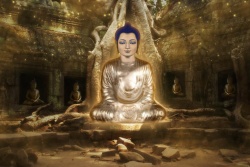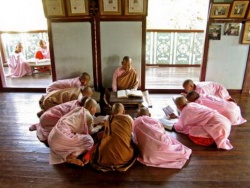Early Buddhist Literature
- The Buddhist Pali Scriptures contain three different collections: the Sutta (relating to the doctrines), the Vinaya (relating to the discipline of the monks) and the Abhidhamma (relating generally to the same subjects as the suttas but dealing with them in a scholastic and technical manner).
Scholars of Buddhistic religious history of modern times have failed as yet to fix any definite dates for the collection or composition of the different parts of the aforesaid canonical literature of the Buddhists.
The suttas were however composed before the Abhidhamma and it is very probable that almost the whole of the canonical works were completed before 241 B.C., the date of the third council during the reign of King Asoka.
The suttas mainly deal with the doctrine (Dhamma) of the Buddhistic faith whereas the Vinaya deals only with the regulations concerning the discipline of the monks.
The subject of the Abhidhamma is mostly the same as that of the suttas, namely, the interpretation of the Dhamma. Buddhaghosa in his introduction to _Atthasalini_, the commentary on the _Dhammasangani_, says that the Abhidhamma is so called (_abhi_ and _dhamma_) because it describes the same Dhammas as are related in the suttas in a more intensified (_dhammatireka_) and specialized (_dhammavisesatthena_) manner.
The Abhidhammas do not give any new doctrines that are not in the suttas, but they deal somewhat elaborately with those that are already found in the suttas.
Buddhaghosa in distinguishing the special features of the suttas from the Abhidhammas says that the acquirement of the former leads one to attain meditation (_samadhi_) whereas the latter leads one to attain wisdom (_pannasampadam_).
The force of this statement probably lies in this, that the dialogues of the suttas leave a chastening effect on the mind, the like of which is not to be found in the Abhidhammas, which busy themselves in enumerating the Buddhistic doctrines and defining them in a technical manner, which is more fitted to produce a reasoned insight into the doctrines than directly to generate a craving for following the path of meditation for the extinction of sorrow.
The Abhidhamma known as the _Kathavatthu_ differs from the other Abhidhammas in this, that it attempts to reduce the views of the heterodox schools to absurdity. The discussions proceed in the form of questions and answers, and the answers of the opponents are often shown to be based on contradictory assumptions.
The suttas contain five groups of collections called the Nikayas.
These are
(1) _Digha Nikaya_, called so on account of the length of the suttas contained in it;
(2) _Majjhima Nikaya_ (middling Nikaya), called so on account of the middling extent of the suttas contained in it;
(3) _Samyutta Nikaya_ (Nikayas relating to special meetings), called samyutta on account of their being delivered owing to the meetings (_samyoga_) of special persons which were the occasions for them;
(4) _Anguttara Nikaya_, so called because in each succeeding book of this work the topics of discussion increase by one [Footnote ref 100];
(5) _Khuddaka Nikaya_ containing _
The Abhidhammas are _Patthana, Dhammasangani, Dhatukatha, Puggalapannatti, Vibhanga, Yamaka_ and _Kathavatthu_.
There exists also a large commentary literature on diverse parts of the above works known as atthakatha.
The work known as _Milinda Panha (questions of King Milinda), of uncertain date, is of considerable philosophical value.
The doctrines and views incorporated in the above literature is generally now known as Sthaviravada or Theravada.
On the origin of the name Theravada (the doctrine of the elders) _Dipavamsa_ says that since the Theras (elders) met (at the first council) and collected the doctrines it was known as the Thera Vada [Footnote ref 101].
It does not appear that Buddhism as it appears in this Pali literature developed much since the time of Buddhaghosa (4OO A.D.), the writer of _Visuddhimagga_ (a compendium of theravada doctrines) and the commentator of _Dighanikaya, Dhammasangani_, etc.
Hindu philosophy in later times seems to have been influenced by the later offshoots of the different schools of Buddhism, but it does not appear that Pali Buddhism had any share in it.
I have not been able to discover any old Hindu writer who could be considered as being acquainted with Pali.


